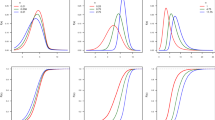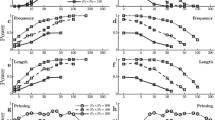Abstract
Most analyses of reaction time (RT) data are conducted by using the statistical techniques with which psychologists are most familiar, such as analysis of variance on the sample mean. Unfortunately, these methods are usually inappropriate for RT data, because they have little power to detect genuine differences in RT between conditions. In addition, some statistical approaches can, under certain circumstances, result in findings that are artifacts of the analysis method itself. A corpus of research has shown more effective analytical methods, such as analyzing the whole RT distribution, although this research has had limited influence. The present article will summarize these ad’ances in methods for analyzing RT data.
Similar content being viewed by others
References
BALOTA, D. A., & SPIELER, D. H. (1999). Word frequency, repetition, and lexicality effects in word recognition tasks: Beyond measures of central tendency. Journal of Experimental Psychology: General, 128, 32–55.
BENTALL, R. P., JONES, R. M., & DICKINS, D. W. (1999). Errors and response latencies as a function of nodal distance in 5-member equivalence classes. The Psychological Record, 49, 93–115.
DIBBETS, P., MAES, J. H. R., & VOSSEN J. M. H. (2002). Contextual dependencies in a stimulus equivalence paradigm. Quarterly Journal of Experimental Psychology, 55B, 97-119.
FIELDS, L., LANDON-JIMENEZ, D. V., BUFFINGTON, D. M., & ADAMS, B.J. (1995). Maintained nodal distance effects after equivalence class formation. Journal of the Experimental Analysis of Behavior, 64, 129–146.
GREENWALD, A. G., NOSEK, B. A., & BANAJI, M. R. (2003). Understanding and using the Implicit Association Test I: An improved scoring algorithm. Journal of Personality and Social Psychology, 85, 197–216.
HERVEY, A. S., EPSTEIN, J. N., CURRY, J. F., TONEV, S., ARNOLD, L. E., CONNERS, C. K., HINSHAW, S. P., SWANSON, J. M., HECHTMAN, L. (2006). Reaction time distribution analysis of neuropsychological performance in an Adhd sample. Child Neuropsychology, 12, 125–140.
IMAM, A. A. (2006). Experimental control of nodality via equal presentations of conditional discriminations in different equivalence protocols under speed and no-speed conditions. Journal of the Experimental Analysis of Behavior, 85, 107–124.
LUCE, R. D. (1986). Response times: Their role in inferring elementary mental organization. New York: Oxford University Press.
MCCULLOUGH, B. D., & WILSON, B. (2002). On the accuracy of statistical procedures in Microsoft Excel 2000 and Excel XP. Computational Statistics & Data Analysis, 40, 713–721.
MILLER, J. (1988). A warning about median reaction time. Journal of Experimental Psychology: Human Perception and Performance, 14, 539-543.
OSBORNE, J. (2002). Notes on the use of data transformations. Practical Assessment, Research & Evaluation, 8(6). Retrieved April 23, 2007, from http://Pareonline.net/
RATCLIFF, R. (1979). Group reaction time distributions and an analysis of distribution statistics. Psychological Bulletin, 86, 446–461.
RATCLIFF, R. (1993). Methods of dealing with reaction time outliers. Psychological Bulletin, 114, 510–532.
ROUDER, J. N., LU, J., SPECKMAN, P., SUN, D., & JIANG, Y. (2005). A hierarchical model for estimating response time distributions. Psychonomic Bulletin & Review, 12, 199–223.
ROUDER, J. N., & SPECKMAN, P. L. (2004). An evaluation of the Vincentizing method of forming group-level response time distributions. Psychonomic Bulletin & Review, 11, 419–427.
ROUDER, J. N., SUN, D., SPECKMAN, P. L., LU, J., & ZHOU, D. (2003). A hierarchical Bayesian statistical framework for skewed variables with an application to response time distributions. Psychometrika, 68, 589–606.
SPENCER, T. J., & CHASE, P. N. (1996). Speed analyses of stimulus equivalence. Journal of the Experimental Analysis of Behavior, 65, 643–659.
THORNTON, T. L., & GILDEN, D. L. (2005). Provenance of correlations in psychological data. Psychonomic Bulletin & Review, 12, 409–441.
ULRICH, R., & MILLER, J. (1994). Effects of truncation of reaction time analysis. Journal of Experimental Psychology: General, 123, 34–80.
VAN ZANDT, T. (2000). How to fit a response time distribution. Psychonomic Bulletin and Review, 7, 424–465.
VAN ZANDT, T. (2002). Analysis of response time distributions. In J. T. Wixted (Ed.), Stevens’ handbook of experimental psychology (3rd ed., pp. 461–516). San Diego, CA: Academic Press.
WILCOX, R.R. (1998). How many discoveries have been lost by ignoring modern statistical methods? American Psychologist, 53, 300–314.
Author information
Authors and Affiliations
Corresponding author
Rights and permissions
About this article
Cite this article
Whelan, R. Effective Analysis of Reaction Time Data. Psychol Rec 58, 475–482 (2008). https://doi.org/10.1007/BF03395630
Published:
Issue Date:
DOI: https://doi.org/10.1007/BF03395630




